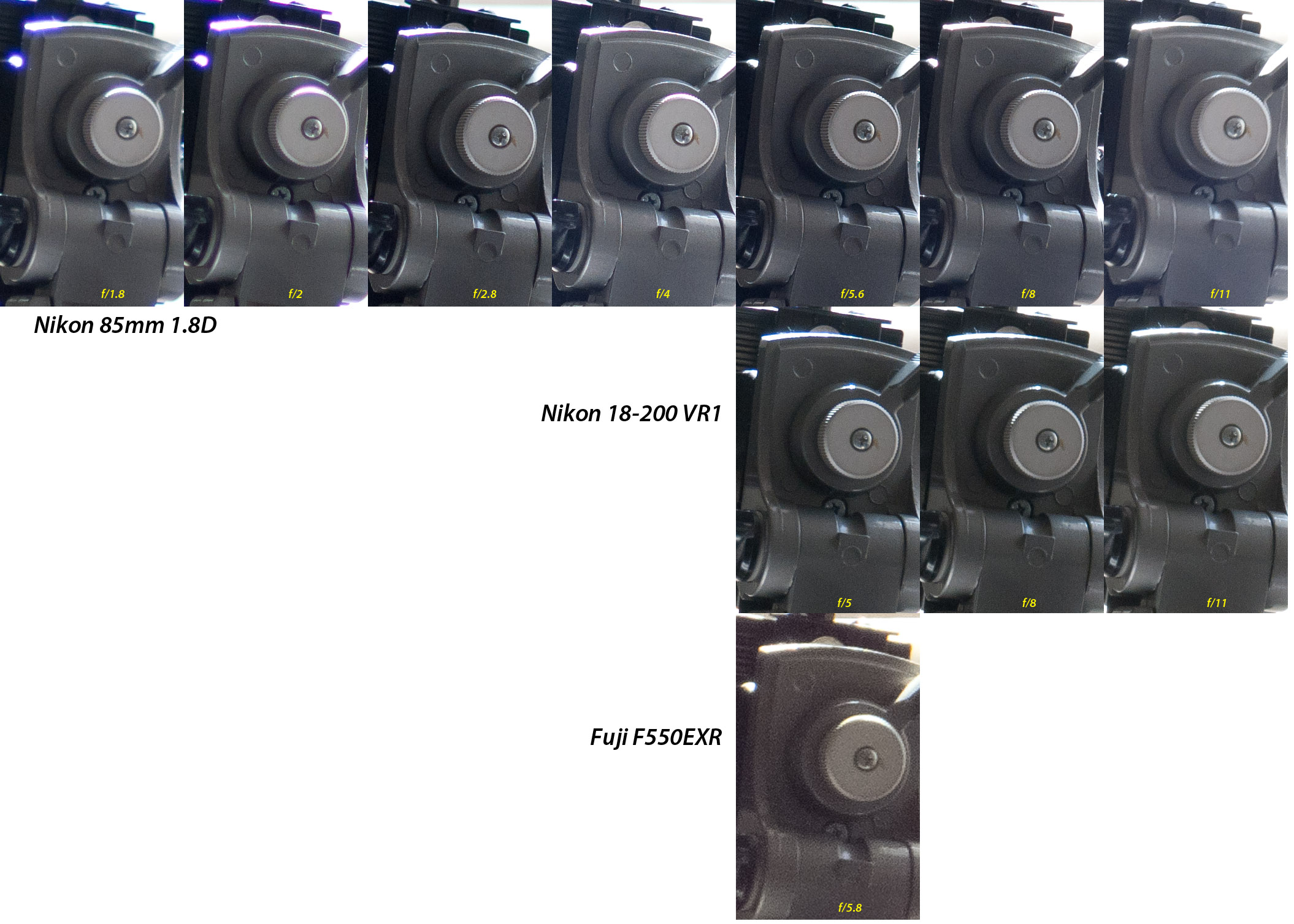This is a rather eclectic test, mixing in several variables and factors and so is useful mainly for observational purposes. In other words, I did not state a hypothesis and then craft a test to prove or disprove it. No scientific method in this one. Sorry.
Anyway, I noted that my el-cheapo Velbon tripod from a century ago was standing in sunlight against a window with the sun hitting the top of it. This created an interesting test subject … dark subject in silhouette with harsh edges bathed in strong sunlight creates a natural test of resolution, shadow noise and chromatic aberration or purple fringing.
Cool.
I was holding the D300 with the 85mm 1.8D mounted, a combination I almost never shoot. What I noticed right away was that it had staggering amounts of fringing when shot wide open. This makes some sense, of course, since fast lenses will do that when overexposed (I shot using spot metering to open the shadows right up, which blew out the edges completely.) Stopping down is normally the cure, so it struck me to run a quick test by shooting at 1.8 on up.
The way I shoot fast lenses is to go just above wide open, in this case f/2 instead of f/1.8. This gives an uptick in performance (better contrast and sharpness) with little loss in subject isolation. So it made sense to include those two apertures and then run a standard ladder … 2.8, 4, 5.6, 8, 11.
After I was done with that, I thought I might try the 18-200VR, since it is so often maligned. And then I thought the F550EXR might make an interesting counterpoint, since it is also often maligned.
The D300 was set to 500 ISO to help the 85 get shutter speeds that were not terrible, as I was hand holding this test (what did I say about the informality of this one ...) In fact, all images were crisp except for f/11. 1/30s is just a little too slow for an effective focal length of 127.5mm hand held.
So let’s see the crops and then I’ll give my observations.
- The colors captured by the 85mm are most accurate. The others are a bit too warm.
- Fringing is rampant on the 85 until 2.8, where it is pretty subtle. It is completely gone by 5.6.
- Sharpness on the 85 improves at f/2 and again at 2.8. Contrast continues to improve slightly, peaking around f/5.6. Amazing lens.
- The 18-200 has some CA wide open, but not all that bad. About equivalent to the 85mm at f/4.
- The 18-200 never reaches the same sharpness as the 85, but is still sharp. Enough that a downsized image is not going to be wildly different looking. Of course, the concept of “bite” in a lens is a subtle thing in the first place. A lot to do with subject isolation and micro-contrast. The 85 has some bite and the 18-200VR does not.
- The F550 is completely outclassed, despite a 2.33 stop advantage in ISO.
- Shadow noise is rampant on the F550, as would be expected on a 1/2” sensor.
- CA (not the blue variety, nor purple fringing) is rampant on the F550, as would be expected from a 15x lens on a $350 camera.
- The F550 image is still fairly sharp, though, so processing it with noise reduction software and improving contrast would provide a decent image.
Conclusion
A fun test. The prime is amazing, although it makes no sense as a wide open bright sunlight lens (which makes no sense anyway.) The 18-200VR is as good as I remember it … sharper than most people credit.
So what is the secret sauce here? Why am I seeing the 18-200VR (1st generation no less) as quite sharp when so many people lambaste it for for sharpness?
The answer is that I perform appropriate capture sharpening in ACR 6.4 on every image in order to overcome the anti-aliasing filter and any inherent lack of sharpness in the lens. This cannot add real sharpness that is not there, which is why the 85 looks better no matter what I do.
But it can allow all of the sharpness that is there to become visible. So yes, the prime took a bit less capture sharpening and so is even that little bit better than shown here, relative to the others.
But that’s the whole point of RAW processing. If you are not going to take advantage of the quality tools that are available, then you really cannot call yourself an enthusiast. By definition, someone who does not process is a point and shooter. Not necessarily a bad thing, but it tends to leave a lot of image quality on the table …

No comments:
Post a Comment